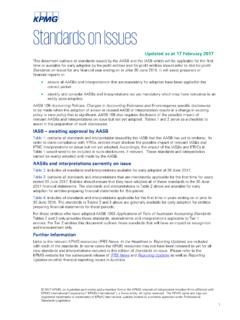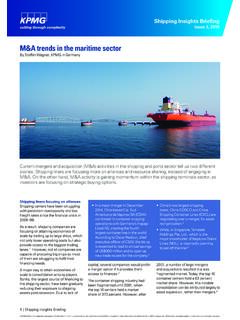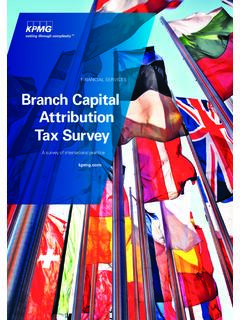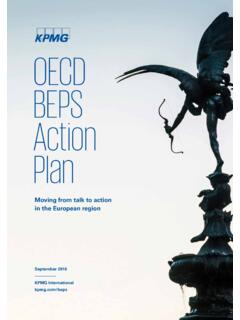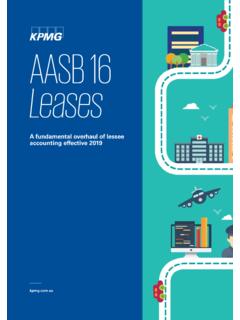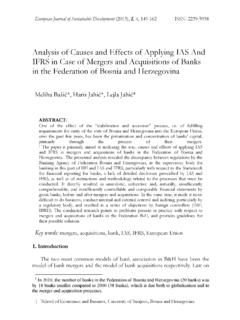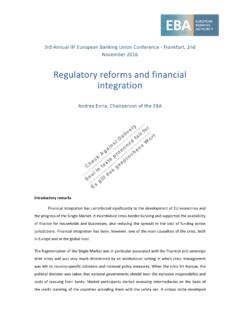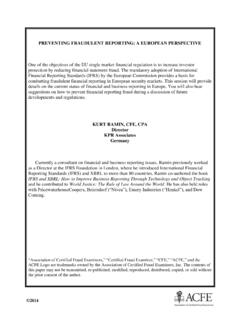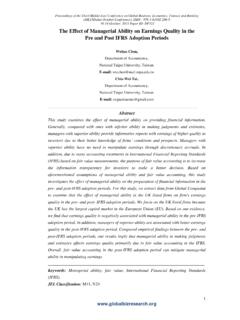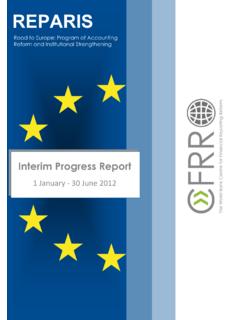Transcription of What lies behind, what lies ahead of ECB’s banking ...
1 what lies behind , what lies ahead of ECB s banking supervision? April 2017 On March 23, the ECB published its Annual Report on supervisory activities 2016 which the ECB presented to the european Parliament (public hearing) and the general media (press conference ). The report includes insights for banks that aim to prioritize their activities with the european banking supervisor. Key achievements in 2016 and continuing activities in 2017 Notwithstanding other areas, the annual report on supervisory activities highlights a number of areas where the ECB has achieved further harmonization in the SSM model of supervision over the course of 2016 (summarized in the following).
2 Key achievements in 2016 Activities in 2017 SREP methodology Correlation between capital requirements and risk profiles further increased (now 76%) Pillar 2 guidance (P2G) introduced MDA trigger decreased (now on average CET1 ratio) No substantial changes expected for 2017 compared to 2016 Targeted Review on Internal Models (TRIM) Preparations for TRIM ( on model selection, guide on risk types and inspection techniques, organizational provisions) Launched 109 internal model (IM) investigations Harmonization of IM assessment practices Continue with targeted review based on developed tools and methods (CR, MR and CCR models) Non-Performing Loans (NPLs) Drafting and consultation of guidance on NPLs (final version published in March 2017 JSTs to actively engage with banks to support implementation of NPL guidance Final report on stock take results of national supervisory practices and legal frameworks (incl.))
3 All Member States) Potential measures to develop secondary NPL-markets (addressing impediments such as a lack of NPL-servicing industry, data quality etc.) On-site supervision 185 on-site inspections (OSIs) approved1 Improved OSI planning ( targeted engagement level, blind spot tracker, shortened duration of missions Revision of credit and IT risk assessment methodology Methodology for analysis of shipping portfolios Improvements of IT risk assessment methodology Guide to on-site inspection Thematic Reviews (TRs) Business models and profitability drivers.
4 Business model classifications, data collections (forecasts and assumptions), guidance for JSTs to support profitability analysis IFRS 9 financial instruments: development of assessment methodology Risk data aggregation (RDA) and risk reporting: developed operational guidelines (guided by BCBS 239), Profitability assessment results will inform SREP (primarily in 2018, by way of benchmarking) IFRS 9 TR to be expected to contribute to IFRS 9 implementation and provisioning policies TR on RDA and risk reporting will feed into SREP deep-dive analysis of liquidity and credit risk Risk governance and appetite: Monitoring of implementations by banks Leveraged finance: Draft guidance (incl.)
5 Consultation) JSTs to focus on challenge processes/abilities of management boards, RAF, effectiveness of limits, interplay between risk appetite and strategy etc. Issuance of final leveraged finance guidance, monitoring of banks appetite for leveraged finance Indirect supervision of Less Significant Institutions (LSIs) Joint Supervisory Standards on supervisory and recovery planning, conduct of OSIs at LSIs, supervision of car financing institutions, licensing of LSIs with FinTech business models Crisis management cooperation framework Trial of SREP methodology for LSIs Improved notification framework between NCAs and the ECB Overall, these achievements and activities are well in line and a follow up of ECB s supervisory priorities for 2017 that were published on December 15 (see figure 1).
6 Figure 1: Supervisory priorities 2016 and 2017. Source: ECB. Click here to enlarge Figure 2: ECB authorizations in banking supervision. Source: ECB. Insights from the annual report The report also includes a number of additional insights that are worth being mentioned here: Authorizations: Altogether, 3,182 authorization procedures were notified to the ECB in 2016, comprising licensing, qualifying holdings, management and supervisory board appointments as well as passporting (see figure 2). Except for the (increased) amount of lapsing of license, the numbers are broadly comparable to 2015.
7 The decrease in passporting procedures is mainly due to improvements in the notification process. In general, the ECB made further efforts to accelerate the processing and facilitate workflows with NCAs. Recovery and Resolution: The ECB assessed recovery plans submitted by banks in 2015 and fed the respective notification letters with the results of benchmarking exercises based on its assessments. Not least to a bilateral Memorandum of Understanding, the cooperation with the SRB was intensified ( information and data exchange in the areas of recovery plans, draft resolution plans, MREL, granting SRB access to ECBs supervisory information IT systems).
8 Budgetary consumption: The ECB expenditures for banking supervision tasks comprise salaries, rent and building maintenance, as well as other operating costs ( IT services, consultancy, trainings). The increase in total expenditure by about 38% (compared to 2015) was primarily caused by decisions and developments from 2015 such as growing staff, relocation to permanent premises and the provision of statistical and IT infrastructure (see table 1) Table 1: Cost of ECB banking Supervision 2014-2016. Source: ECB. (in millions) 2014 2015 2016 Salaries and benefits Rent and building maintenance Other operating expenditures Total expenditures Insights from the public hearing and press conference on the annual report During the press conference , Daniele Nouy (Chair of the Supervisory Board of the ECB) and Sabine Lautenschl ger (Vice-Chair of the Supervisory Board of the ECB) provided also some of their views on current challenges within the SSM: Consolidation.
9 The need for consolidation in the Euro area banking sector was emphasized during the press conference and the facilitation of cross-border mergers was repeatedly mentioned as goal of the banking union (which would imply some sort of support by the ECB for cross-border mergers). However, since the ECB cannot actively push for consolidation and no specific measures for cross-border mergers are mentioned in the annual report, consolidation most likely will continue to be one of the items on ECB s wish list instead of its list of supervisory priorities.
10 Non-Performing Loans: The ECB treated NPLs as one of their priorities in 2016 and sees some success in 2016 in the reduction of NPL inventories (fallen by 54 billion to of total loans). The publication of the final NPL guidance is regarded as a major milestone. The ECB s next step regarding NPLs will be to formulate expectations for banks steady-state ( appropriate in- and outflows of NPLs on bank-level). With regard to the proposal of a european bad bank, Nouy considers this to be one tool among others for the NPL workout, but not a silver bullet which could lower the stigma for NPL selling banks and increase the NPL sellers bargaining power.
